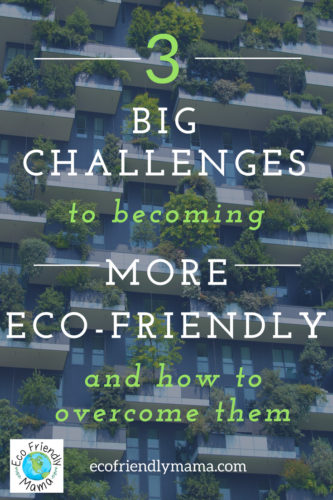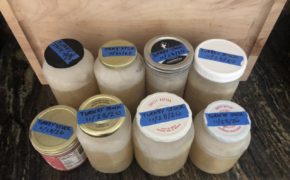3 Big Challenges To Becoming More Eco Friendly And How To Overcome Them
If you’re reading this, I think it’s safe to assume you are interested in living a greener lifestyle but perhaps are unsure of how to go about it and find the process of becoming more eco friendly daunting. Either that, or you’re family and read everything I write no matter the subject (hi dad!).
When I first started becoming more eco-conscious, it was a process (and still is). It’s like this beautiful quote from Lao Tzu:
Eco-friendly habits are built up over time, day after day, until they just become ingrained in your routine and thought process. As I wrote in my post about 3 Easy Ways To Be More Eco-Friendly…Right Now, it took me months if not years to remember to bring my own reusable bags on shopping trips. But now, it’s as natural as walking out of the house wearing matching shoes…which I do *most* of the time lol.
That said, remembering to be eco-friendly isn’t the only challenge to living a greener life. Here are 3 big hurdles you may face and how to overcome them:
Challenge #1 – The Stigma
No one wants to be perceived as a kook, an outlier, or worse still, someone who is overly frugal to the point of being a miser. Bringing your own bags for a 10 cent discount or asking to skip a straw at the restaurant may make you feel this way.
The Solution
To be honest, I find that this fear of being seen as a planet-hugging nutcase is mostly in my head. Don’t get me wrong: there has been the occasional restaurant server who subtly rolled their eyes when I’ve asked for water without a plastic straw. But for the most part, if I have a smile on my face when I ask to skip the straw, or I politely explain that I’m trying to avoid plastic waste, most people are supportive of this concept. I’ve been surprised many times in fact by people who I didn’t think had an awareness for the environment (purely based on my own incorrect stereotyping) who have reacted positively to my efforts. And with giant companies like Starbucks, KFC, and Marriott Hotels joining the effort to reduce their plastic waste, it’s feeling less like an unconventional choice and more like a trend-setting one.
This is like any problem, really. The more you talk about it openly, the less it feels like a problem. And who knows, maybe the person who’s bagging your groceries in the insulated bag you brought from home will be inspired by your example to think twice the next time they go shopping themselves.
Challenge #2 – Availability
Walk into your typical grocery store and it feels like organic and sustainable items are few and far between. If you’re lucky, your local super market will have part of an aisle devoted to organic products next to the Asian and Hispanic foods. (At least, that’s how it is at the giant grocery store near my house. Meanwhile there’s a mile’s worth of sugary cereals and highly processed food). Same goes for sustainably-made clothing, non-toxic cleaning products, etc.
The Solution
The reality is, there are eco-friendly alternatives to basically everything you can find in a typical grocery store: from sponges to ice cream and everything in between. With the rise of affordable grocery delivery services like AmazonFresh (Affiliate link) and InstaCart, it’s possible to have green products delivered right to your door. We buy many of our non-toxic cleaning products in bulk quantities via Amazon Prime (Affiliate link). Having a Prime membership means we get free two day shipping and could order these items in small quantities whenever we need them. But shopping in bulk reduces the packaging waste too.
By the way, if you’d like to try Prime, they’re having a free 30 day trial offer right now – click here to sign up using my Affiliate link! And you can also try a free trial for AmazonFresh by clicking here. (Full disclosure: these are affiliate links, but don’t cost you anything to use, and help me to support this pricy blogging habit I’ve got going on here).
Many stores are getting in the act now. Recently I wrote about Whole Foods, which is already a sustainability-focused grocer, expanding their brand with Whole Foods 365 stores across the country. These stores carry more affordable options but maintain the same focus on non-GMO, sustainably produced, and additive-free products that regular Whole Foods stores do.
Availability goes beyond grocery stores too. For instance, H&M now has an entire line devoted to organic designs called Conscious, which is sold both in their stores and online. It seems like every day I notice a new organic product or sustainably-made item coming to market.
And the best way to encourage more companies to make eco-friendly products is to use your wallet. More on that below.
Challenge #3 – The Cost
This is a big factor I think for everyone who is interested in being kinder to the earth but also feels limited by their budget. Organic alternatives can be (whether real or perceived to be) more expensive than their mainstream counterparts. This may be due to having a higher quality of materials, not being mass produced at a lower cost by exploiting cheap labor, or not yet having enough competing producers to drive the prices down.
The Solution
There are in fact many DIY alternatives that are actually cheaper than the store-bought equivalent and more eco-friendly too. Of course, not everyone has time to DIY all their products and that is okay. For this I suggest buying in bulk or reframing your budgeting focus from short term to long term costs.
Costco of all places has a wide variety of eco-friendly and organic products. For instance, we sometimes buy our organic multi-grain bread there. (Other times I buy it fresh from the bakery and bring my own canvas bag to put it in). It’s sold in a two-pack, and we put one right in the freezer for later use. When it comes time to eat, I just put a slice in the toaster oven for about 5 minutes.
Fact: frozen bread tastes just as delicious after toasting as fresh bread. Learned that trick from my father-in-law.
On a recent trip to Costco, I noticed that they were selling an eco-friendly detergent in the same size but at a lower price than a popular mainstream brand. People were ignoring the green product and paying more to put the one with chemicals and dyes into their cart. And the eco-friendly one works just as well (I speak from personal experience). The idea that eco-friendly products cost more than “regular” items is no longer true!
Also, while some sustainably-sourced products may still appear to be far more expensive than their conventional/plastic alternatives, if you think about how long those products last, they usually end up making up for their cost. I wrote specifically about this concept in my post about reusable sandwich bags.
Though a green product can be pricer as a one-time purchase than its disposable counterpart, you have to think about the “cost per use” over time too.
Hypothetically, instead of spending say $5 on a box of plastic sandwich bags, you spend say $10 on a reusable alternative. But that reusable bag will last you for a year or longer. Meanwhile, you’re probably buying at least a few more boxes of disposable bags over the course of the year, which all typically end up in landfill after one use. Now multiply that by how many lunches you’ll be packing over the course of your lifetime, or how many disposable products you’re buying that have reusable alternatives, and that makes buying disposable products a far costlier way to spend your hard-earned money.
Here’s a more specific example:
My daughter has started taking ballet classes. This is a class for toddlers, so there’s a lot of wandering around, laying on the floor, and general randomness. But they’re expected to dress the part and wear ballet slippers. Target currently sells some that are made from synthetic materials for around $15. By the way, Polyurethane, which is what this one is made from primarily, is a type of plastic.
They look fine, but will eventually start to peel and are neither recyclable nor biodegradable. I decided to buy these real leather Capezio pink slippers from Amazon. Capezio is one of the top dancer brands, and they come in both narrow and wide sizes. While these cost about $5 more than Target’s option for my daughter’s size, they were still a steal at under $20. Better yet, since they will last longer than the synthetic version and are a more “sought-after” brand, their resale value is higher too.
NOTE: On the eve of publishing this post, I checked the Capezio shoes on Amazon and found they are currently on sale and cost the same as the synthetic option from Target. If you’ve got a kiddo in ballet, now’s the time to buy these slippers!
What’s The Next Step?
Hopefully if you’ve read this far in the post, you feel confident about overcoming these perceived challenges to going green. Ready to get started?
Check out my post on 3 Easy Ways To Be More Eco-Friendly…Right Now.
Buy some reusable sandwich bags.
Invest in sustainably-made beauty products.
Switch to a non-toxic stain remover.
Skip a plastic straw or other non-recyclable item.
Or simply continue to use something even though it no longer is the shiny new toy it once was.
Have another tip to overcoming these challenges or want to share how you have gotten past these hurdles yourself? Please leave a comment below – I’d love to hear from you!







Jill
Great article filled with lots of good tips! I was just at target looking at their ballet shoes for little ones and had the same thought. Thanks for sharing your recommendation on a better eco friendly option that won’t break the bank!
Eco Friendly Mama
Thank you! Glad I could help : )
Lanell
I will be paying attention to these tools and ideas when shopping. Thanks!?
Eco Friendly Mama
Awesome!
Brittany
It’s cool to see so many stores becoming more eco friendly. I had no idea H&M had a clothing line like that.
Eco Friendly Mama
Right?! I hope it’s a direction we’ll be seeing more companies move towards in the future.
Ana
Very informative. Here in Europe, more precisely around Amsterdam area, everyone is pretty obsessed with becoming eco-friendly. The organic market is booming, everyone is bringing a shopper, etc. I mean there is no stigma. But you go more towards East of Europe people are definitely not very concerned about the environment. It is a struggle for me to see a forest in Romania who is packed with plastic.
Eco Friendly Mama
Yeah, I hear you on that frustration. It’s encouraging to know Amsterdam is leading the way though. Hopefully other parts of Europe will start to pay attention and follow suit eventually.
Jasmine
i think these are great solutions and theres nothing wrong with opting out of plastic choices. its when people force their thinking and choices on others, like the plastic straw ban, that bother me. Your choices shouldn’t affect others, like the disabled, negatively.
Eco Friendly Mama
I have a disabled family member who is dependent on drinking through straws so I know where your concern is coming from and know it’s a complicated issue from a convenience stand point. Companies that have decided to stop using plastic straws, like KFC for example, have stated that they will still have plastic straws available on request to those that need them. No one is intent on taking a convenience away from the truly needy. The ADA protects the rights of the disabled here in the US after all. I expect that another solution will be found to replace plastic straws permanently, or make recycling them more commonplace, either of which will be better for the environment than the current situation!
Haley
This is great information! So important to be eco-friendly!
Eco Friendly Mama
Thanks for reading!